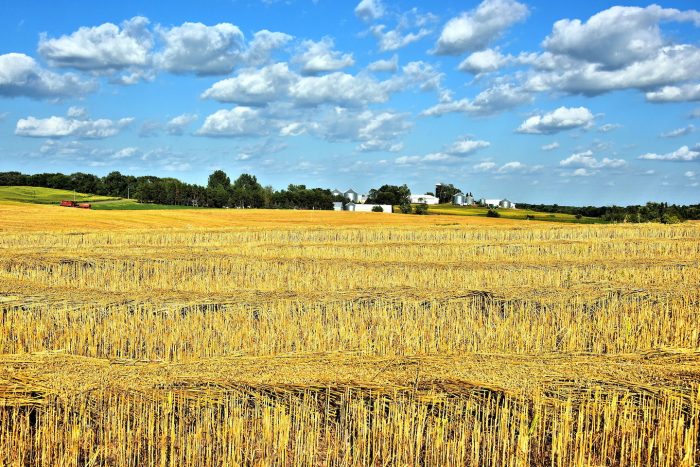Gently flows the amber grain, a phrase that evokes a sense of peace, tranquility, and abundance. This exploration delves into the historical significance, poetic interpretation, and artistic representations associated with this evocative expression.
From its agricultural roots to its literary and cultural impact, “gently flows the amber grain” has captivated imaginations and inspired countless works of art.
Historical Context: Gently Flows The Amber Grain

The phrase “gently flows the amber grain” has its roots in the agricultural practices and the beauty of nature observed by farmers and poets throughout history.
The “amber grain” refers to ripe wheat or barley, which takes on a golden-amber hue when ready for harvest. The “gently flows” part describes the graceful movement of the grain stalks swaying in the breeze, creating a mesmerizing sight in the fields.
Origins in Agriculture
In ancient times, agriculture was a vital part of life, and the harvest was a time of celebration and abundance. Farmers would work tirelessly to cultivate their fields, and the sight of the golden grain ripening in the sun was a symbol of their hard work and the promise of a bountiful harvest.
The phrase “gently flows the amber grain” captured the essence of this agricultural tradition and the beauty of the natural world. It became a way to express the gratitude for the land’s bounty and the hope for a prosperous future.
Poetic Interpretation
The phrase “gently flows the amber grain” evokes a sense of peace, tranquility, and abundance. The imagery of amber grain flowing gently suggests a tranquil scene of nature, where the fields are ripe with grain and the breeze whispers through the stalks.
Symbolism of Amber Grain
The amber color of the grain symbolizes the richness and warmth of the harvest. It also represents the golden age of prosperity and abundance. The flowing motion of the grain suggests a sense of continuous growth and renewal, reminding us of the cyclical nature of life and the bounty of nature.
Sense of Peace and Tranquility
The gentle flow of the grain creates a sense of peace and tranquility. The image of the wind gently moving through the stalks suggests a sense of calm and serenity. The swaying motion of the grain also evokes a feeling of harmony and balance.
Gently flows the amber grain, rustling in the summer breeze. For those seeking a comprehensive study guide to conquer the Praxis 5354 exam, here’s an invaluable resource . With its detailed content and practice questions, you’ll glide through the amber waves of knowledge and emerge as a confident test-taker.
As the golden fields sway, so too will your preparation for Praxis 5354, leading you to a fruitful harvest of success.
Abundance and Prosperity, Gently flows the amber grain
The abundance of the grain symbolizes prosperity and wealth. The fields of ripe grain represent the fruits of labor and the blessings of nature. The gentle flow of the grain suggests a continuous supply of sustenance, reminding us of the abundance that surrounds us.
Artistic Representations

The phrase “gently flows the amber grain” has inspired numerous artistic interpretations, each capturing the essence of the phrase in a unique way. These artworks range from serene landscapes to vibrant depictions of rural life, reflecting the beauty and tranquility of the natural world.
Paintings
One notable example is the painting “The Gleaners” by Jean-François Millet, which depicts a group of women harvesting wheat in a field. The painting captures the laborious nature of their work while also conveying a sense of peace and harmony.
The amber-colored grain flows gently across the canvas, creating a sense of movement and abundance.
Sculptures
The phrase has also been interpreted in sculptures, such as “The Sower” by Jean-Baptiste Carpeaux. This sculpture depicts a farmer sowing seeds in a field, with the flowing grain represented by bronze. The sculpture conveys the strength and determination of the farmer as he works the land, while also capturing the beauty of the natural cycle of growth.
Nature’s Symphony

The flow of grain creates a symphony of sounds and rhythms that captures the essence of nature. The rustling of stalks against each other creates a gentle, whispering melody, while the swaying of heads in the breeze produces a soft, rhythmic swish.
The Harmony of Nature
- The rustling of stalks creates a gentle, whispering melody, like the soft whispers of a summer breeze.
- The swaying of heads in the breeze produces a soft, rhythmic swish, like the gentle lapping of waves on a distant shore.
- Together, these sounds blend seamlessly, creating a harmonious symphony that evokes a sense of peace and tranquility.
Comparative Analysis

The phrase “gently flows the amber grain” is a unique and evocative description of a wheat field, capturing its graceful movement and warm color. It is often compared to other similar phrases or literary devices, each with its own distinct qualities and impact.
Similarities and Differences
One common literary device used to describe nature is personification, where human qualities are attributed to non-human entities. In “gently flows the amber grain,” the grain is personified as flowing, giving it a sense of agency and movement. This is similar to other phrases like “the wind whispers through the trees” or “the river dances over the rocks,” where natural elements are given human-like characteristics.
However, the phrase “gently flows the amber grain” also differs from these other examples in its specificity. The use of “amber” to describe the color of the grain adds a richness and warmth to the image, evoking the golden hues of ripe wheat.
This specific and evocative language sets the phrase apart from more general descriptions of nature.
Impact of the Phrase
The impact of the phrase “gently flows the amber grain” is its ability to create a vivid and memorable image in the reader’s mind. The gentle movement of the grain and the warm color of the amber create a sense of tranquility and beauty.
The phrase also evokes a sense of abundance and prosperity, as the flowing grain represents a bountiful harvest.
In comparison to other similar phrases, “gently flows the amber grain” stands out for its specificity and evocative language. It is a unique and memorable description of a wheat field that captures its beauty and abundance.
Table of Grain Varieties
The phrase “gently flows the amber grain” in the poem evokes images of rolling fields of grain, each variety possessing unique characteristics and associations.
This table presents an overview of different grain varieties, highlighting their color, texture, and symbolism within the context of the poem:
| Grain Type | Color | Texture | Symbolism |
|---|---|---|---|
| Wheat | Golden yellow | Smooth and firm | Abundance, prosperity, and nourishment |
| Barley | Pale yellow | Rough and coarse | Strength, endurance, and sustenance |
| Oats | Light brown | Soft and fibrous | Health, vitality, and nourishment |
| Rye | Dark brown | Dense and chewy | Hardiness, resilience, and adaptability |
| Corn | White, yellow, or orange | Sweet and starchy | Plenty, abundance, and sustenance |
Literary and Cultural Impact
The phrase “gently flows the amber grain” has resonated deeply within the realms of literature, music, and popular culture, leaving an enduring legacy.
Literary Allusions
The evocative imagery of the phrase has inspired numerous literary allusions and references. In George Orwell’s dystopian novel “1984,” the protagonist Winston Smith finds solace in reciting the line as a symbol of freedom and resistance against the oppressive regime.
In J.R.R. Tolkien’s epic fantasy “The Lord of the Rings,” the phrase is echoed in the song “The Green Fields of Rohan,” describing the vast and idyllic plains of the Rohirrim.
Musical Adaptations
The phrase has also found expression in the world of music. In 1970, the American folk singer Bob Dylan released the song “Blowin’ in the Wind,” which includes the line “How many times can a man turn his head / And pretend that he just doesn’t see?” The song became an anthem for the civil rights movement and was later covered by countless artists.
Popular Culture
Beyond the realm of literature and music, the phrase “gently flows the amber grain” has permeated popular culture. It has been used in advertisements, television shows, and even video games. The phrase evokes a sense of tranquility and nostalgia, connecting with audiences on an emotional level.
FAQ Overview
What is the origin of the phrase “gently flows the amber grain”?
The phrase originates from the ancient practice of agriculture, where the golden color of ripening grain resembled amber.
How does the phrase capture the essence of nature?
The phrase evokes the gentle movement of grain in the wind, creating a symphony of sounds and rhythms that represent the harmony of nature.